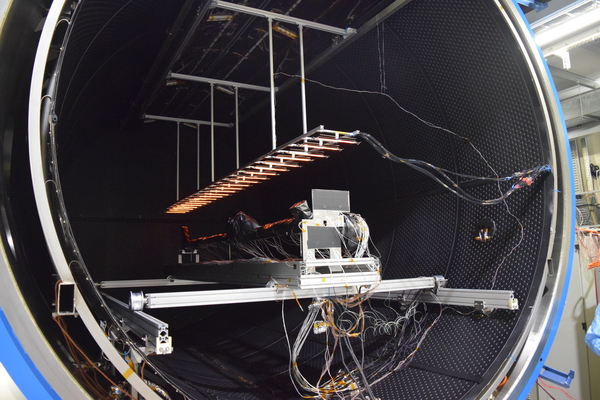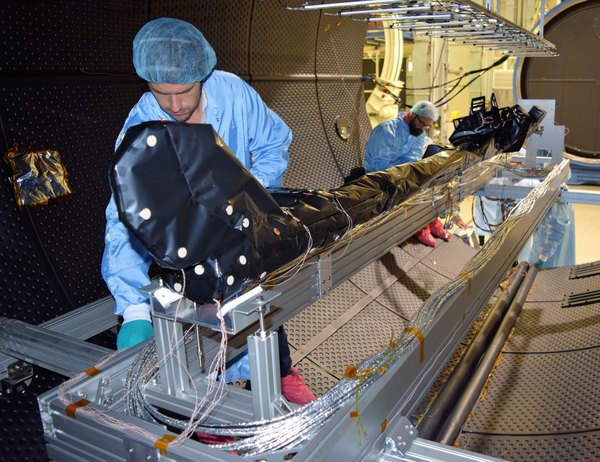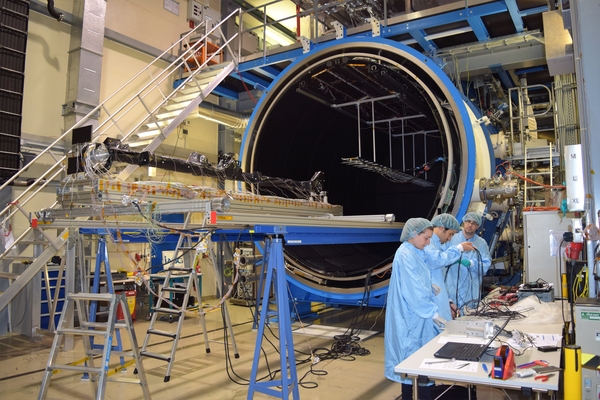#2: Thermal testing of the magnetometer boom
6 November 2018
During August, the JUICE Test Campaign switched to thermal tests of a Structural and Thermal Model (STM) of a segment of the magnetometer (MAG) boom, equipped with five STMs of the scientific sensors. |
| JUICE magnetometer boom in thermal vacuum chamber. Credit: ESA/SENER/IABG |
The tests were run as part of the MAG boom development programme in order to validate current engineering assumptions and guarantee the overall thermal performance of the boom and of the sensors attached to it.
To carry out its ambitious science objectives, the JUICE spacecraft will carry a state-of-the-art scientific payload that constitutes one of the most powerful instrument suites ever flown to the outer Solar System. These instruments will carry out remote sensing, geophysical measurements and in situ studies.
The objective of the in situ instruments, in particular, is to provide data on Jupiter's magnetosphere, plasma and the fields surrounding its giant moons. Among these instruments are:
- The J-MAG magnetometer, which is based on three sensors (two fluxgate magnetometers and a scalar magnetometer) mounted on the MAG boom. These sensors will measure the direct current (DC) magnetic field vector and magnitude in the spacecraft's vicinity.
- The Radio and Plasma Wave Instrument (RPWI), which will perform several types of measurements in the environment of Jupiter and its icy moons: plasma waves electrical and magnetic measurements, plasma measurements, radio emission measurements, and electric field measurements. The RPWI instrument has two sensors mounted on the MAG boom, in addition to other sensors mounted on four additional booms.
In order to minimise magnetic disturbances from the spacecraft and allow for accurate measurements, the five sensors for these instruments are located on the outer segment of the 10.6-m long boom.
 |
| Testing the JUICE magnetometer boom for extreme temperatures. Credit: ESA/SENER/IABG |
The MAG boom consists of three segments connected through hinges. It will be stowed during launch in a folded configuration along one of the lateral panels of the spacecraft, and deployed in orbit to reach its full length.
During its cruise to Jupiter, the JUICE spacecraft and its deployed MAG boom will be subjected to extreme thermal variations. When it is closest to the Sun, the spacecraft will be exposed to a solar flux density of 3300 W/m², which is almost 2.5 times the average solar illumination in Earth's vicinity. At Jupiter, the flux density will be only about 50 W/m², or roughly 4 percent of the average solar illumination at Earth's distance.
During its mission in the Jupiter system, the spacecraft, and with it the MAG boom, will also have to withstand many eclipse periods in the shadow of Jupiter that will last up to four hours, experiencing temperatures as low as -250°C.
The MAG boom and the scientific sensors it hosts are designed to withstand such an extreme temperature range. This is achieved by passive thermal control, which is essentially based on high temperature Multi Layer Insulation (MLI) supported by local heaters, with limited power to save spacecraft resources in Jovian environment.
The capacity to withstand extreme thermal environments during the mission making use of the allocated power budget was initially verified by calculations using numerical thermal models.
An early thermal balance test was then implemented as part of the MAG boom development programme, in order to validate the engineering assumptions and guarantee the overall thermal performance of the MAG boom and its scientific sensors.
This test was based on a Structural and Thermal Model (STM) of the outer, 3.6 metre long segment of the MAG boom, equipped with five STMs of the scientific sensors, all of which were representative of the flight hardware in terms of thermal, dissipated power and mechanical configurations.
 |
| Testing the JUICE magnetometer boom. Credit: ESA/SENER/IABG |
The two extreme thermal environments were simulated in a vacuum chamber located at the IABG test centre in Ottobrunn, Germany, between 11 and 15 August. The chamber was cooled by liquid nitrogen to -180°C, in order to reproduce the deep cold of space.
The closest approach to the Sun was simulated using 22 infrared lamps that were directed toward the side of the outer MAG boom segment that is planned to face the Sun.
This simulation required a total of about 16 000 W of lamp power. The hottest measured temperature on the surface of the MAG boom thermal insulation was +227°C, whereas the opposite side, only 10 cm away from the hottest point, was around -170°C.
To simulate the Jovian environment in the same frigid vacuum chamber, all of the lamps were then switched off and the MAG boom was kept in the dark. Only half a watt of power provided by local heaters on the sensors was sufficient to keep the 3.6 m long boom segment above -150°C, and most of the scientific sensors were even warmer.
The data from more than 100 temperature measurements have now been analysed and used to update and validate the thermal mathematical model, a key step to ensure that the MAG boom and its five scientific sensors will survive the thermal extremes of both the spacecraft's long cruise to Jupiter and of the giant planet's environment.
About JUICE
JUICE – JUpiter ICy moons Explorer – is the first large-class mission in ESA's Cosmic Vision 2015-2025 programme. It will complete a unique tour of the Jupiter system that will include in-depth studies of three potentially ocean-bearing satellites, Ganymede, Europa and Callisto.
The Jupiter tour includes several flybys of each planet-sized world, and it ends with orbit insertion around Ganymede, the largest moon in the Solar System.
JUICE will carry the most powerful scientific payload ever flown to the outer Solar System. It consists of 10 state-of-the-art instruments plus one experiment that uses the spacecraft telecommunication system with ground-based instruments.
JUICE's instruments will enable scientists to compare each of these icy satellites and to investigate the potential for such bodies to harbour habitable environments such as subsurface oceans. They will also carry out observations of Jupiter, its atmosphere, magnetosphere, satellites and rings.
About the MAG boom and payload
The MAG boom is provided by SENER, Spain. The boom hosts sensors for two instruments: J-MAG – A magnetometer instrument for JUICE, provided by Imperial College London, UK; and RPWI – Radio & Plasma Wave Investigation, provided by the Swedish Institute of Space Physics (Institutet för rymdfysik, IRF), Uppsala, Sweden.



